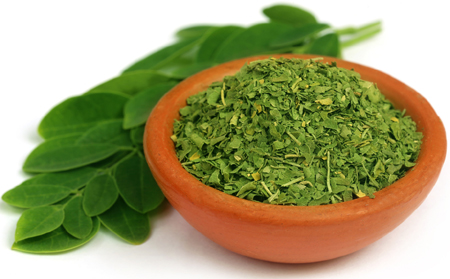Moringa Leaves Have Antioxidant, Anti-diabetic and Anti-microbial Medicinal Properties
Moringa leaves, from a particular variety of Moringa oleifera, frequently found in Asia, South America, and Africa have potent medicinal and nutritional properties. Ancient Maurian warriors of India popularized the extraction and consumption of Moringa oleifera leaf extract laced with conventional stimulants as a stress-relieving and energy-boosting potion. Local South Americans have been using moringa leaves in curing both acute and chronic ailments.
Features of Moringa Leaves

Morphological knowledge of Moringa oleifera leaves is an essential criterion for recognizing their benefits. Though it belongs to a botanical class of many similar plants, Moringa oleifera has unique representative features for easy identification regardless of the region where it is cultivated.
Moringa leaves have a feathery foliage texture, with almost no perceptible feel of hair on the surface (unlike Moringa robusta). The leaves are prominently green-colored, arranged alternately in 2s along opposing side of its fragile, spreading branches and in 3s on the apex. However, on close examination, moringa leaves are commonly tripinnate or bipinnate, forming the wild illusion of a hanging string-of-palms. Each compound leaflet measures about 1 - 2 cm long, elliptical to obovate, and hanging luxuriously on hairy, green branch-supported twigs. In contrast to other plants in its family, these features are unique to the leaves of Moringa oleifera. (1)
The Moringa tree is called with various names in different parts of the world. Famous names include; Drumstick tree (English), Morungue (French), Rawag (Arabic) Angela, Ben (Spanish), La ken (Chinese), and Suhanjna (Urdu), Saguna (Hindi). The names essentially describe the same leaf.
Constituents of Moringa Leaves
The chemical composition of Moringa oleifera leaves may slightly vary according to the region of cultivation, with studies reporting a higher presence of nutritive phytochemicals in semi-deciduous zones when compared with Moringa germinates in Savannah, Georgia. The lower quality leaf extracts of Moringa plants in the Savannah has been attributed to high temperature-induced decomposition of useful constituents.
Do you wonder what these constituents might be?
Extensive studies by interested nutritionists and ethnomedicine experts reveal that the highly regarded constituents of Moringa oleifera leaves include; Vitamins (vitamin B1, vitamin A, vitamin C, vitamin B2, alpha and gamma-tocopherol), Amino acids (arginine, histidine, phenylalanine, threonine, leucine, tryptophan, lysine, valine), Minerals (calcium, iron, potassium, magnesium, sulphur), Phytochemicals (flavonoids, saponins, terpenoids, tannins, sterols), fat proteins and fibers (2). However, the relative level of useful constituents available in each extract of the leaf depends mostly on the methods of cultivation, storage, preservation, and extraction. (Click for more details)
How to Process Moringa Leaves?
The ancient use of Moringa Oleifera leaves for different medicinal purposes was preceded by various unorthodox, poorly documented approach of extracting the liquid, bitter-tasting concoction regarded as the magical component of Moringa. Recently, a study has established that Moringa leaves may lose some of its nutrients while washing them with boiled water for a couple of minutes but also reduce the oxalate, phytate, and cyanide components, which may be considered harmful. The resulting slightly bitter extract can be flavored, stored, and used for various medicinal purposes. The fresh leaves are harvested during active germination and preserved by drying and freezing in a low-temperature oven.
At a temperature below 2 ˚C, the dehydrated leaves contain a significant proportion of retained nutrients when compared with other crude preservative and storage techniques. In many climes, preservation and storage of fresh Moringa leaves can be achieved cheaply on a low budget by implementing the use of ordinary housewares and appliances. This method has also been validated to elongate the shelf life of Moringa leaves without a degrading change in nutritive and medicinal components.
Medicinal and Nutritional Properties
From the ages of Pythagoras and the early philosophers, the incorporation of processed Moringa oleifera leaves in diet, and its use in health has been guided mainly by oral traditions and myths. The ayurvedic system of medicine employed Moringa as a supplement due to its perceived water purification, anxiety-relieving, and high nutritional properties.
Evidently, Moringa oleifera leaf serves potential nutritive importance in the world of medicinal plants. Some valuable medicinal properties include:
Antioxidant activity
Antioxidants are the class of drugs that protect the body cells against the harmful effects of free radicals. High-fat diet, radiation exposure, and oxidative stress are common factors generating free radicals in the body cells. In these cells, alcoholic and aqueous extract of Moringa oleifera leaf mop up all free radicals and prevent oxidative damage of the body tissues. The phenolic and flavonoid constituents have been attributed to the antioxidant property of the extract. This property is enough to consider Moringa Oleifera leaf extract as a potential cancer-treating approach in the future of modern medicine (4).
Anti-diabetic activity
Moringa leaf extracts have long been claimed to affect glycemic control in diabetics. In 2013, a study on beta-cell dysfunction published by the Asian Journal of Pharmaceutical and Clinical Research proved that a systematic treatment with Moringa extracts cured bacteria-induced Type 1 diabetes and insulin-resistant Type 2 diabetes. This study was done in rats as a model for human treatment approach.
Promotes cognitive Functions
Cognitive derangement in humans has been linked to a lowered level of brain monoamines. Drug therapy is aimed at restoring these important bioactive components necessary for improved physiological function in humans. Recently, ethanolic extract of Moringa oleifera leaves has been researched to restore the monoamines and subsequently mitigate degradation of the restored amines. Currently, funded researches are underway to determine the possible use of Moringa extracts in the management of Alzheimer's disease, convulsion, locomotory dysfunction, schizophrenia, and other central nervous system disorders.
Anti-microbial activity
Pterygospermin, the apparent magical component of the Moringa leave extract is a potent fungicide with significant action against disease-causing microorganisms, including staphylococcus aureus and pseudomonas aeruginosa. Other studies confirm complementary antibacterial activity from water-soluble lectin isolates of Moringa leaf extracts. Both isolates have been proved to adversely affect the growth, survival, and pathogenesis of various harmful microbial species (6).
Other studies are ongoing to establish the anticancer, pain-relieving, hepatoprotective, diuretic, and anti-ulcer properties of Moringa leaf.
How useful could such a readily available plant leaf be?
No doubt, the use of Moringa oleifera leaf has been grossly underrated in regions of the world where it grows naturally. Moringa should be an essential part of a household dieting plan.
References:
1) J.L. Rockwood, B.G. Anderson, D.A. Casamatta, Potential uses of Moringa oleifera and an examination of antibiotic efficacy conferred by M. oleifera seed and leaf extracts using crude extraction techniques available to under-served indigenous populations, Int. J. Phytotherapy Res. 3 (2013) 61–71 (www.feedipedia.org/node/124)
2) African Journal of Biotechnology. (2011)
Nutritional characterization of Moringa (Moringa oleifera Lam.) leaves.
Authors; B. Moyo, P. Masika, A. Hugo, and V. Muchenje,
3) Journal of Biology, Agriculture, and Healthcare (2016)
Biochemical Studies on Moringa Oleifera Leaves Extract
Authors; Nazmy, S. Erian, Hassan, B. Hamed, Nihad A. A. Alnidawi, Abeer, Elhalwagi, and M. Farid.
https://www.researchgate.net/publication/323425319
4) African Journal of Traditional, Complementary, and Alternative Medicines. 2006
Phytochemical screening and antiulcerogenic effect of Moringa oleifera aqueous leaf extract.
Authors; Dahiru D, Onubiyi JA, Umaru HA.
5) The Journal of Phytopharmacology. 2018.
Phytochemistry and Pharmacology of Moringa oleifera
Authors; Birendra Kumar Paikra, Hemant Kumar J. Dhongade, and Bina Gidwani, www.phytopharmajournal.com
6) Amrutia J, Lala M, Srinivasa, Moses RS. Anticonvulsant
activity of Moringa oleifera leaf. International Research
Journal of Pharmacy. 2011;2(7):160-2
7) International Journal of Phytothearpy Research (2013)
Potential uses of Moringa oleifera and an examination of antibiotic efficacy conferred by M. oleifera seed and leaf extracts using crude extraction techniques available to underserved Indigenous populations
Authors; J.L.Rockwood, B.G. Anderson, and D.A.Casamatta.
8) Bhat SK, Joy AE. Antianxiety effect of ethanolic extract of leaves of
Moringa oleifera in Swiss albino mice. Archives of Medicine and Health
Sciences. 2014; 2(1):5-7.
9) I.J. Asiedu-Gyekye, S. Frimpong-Manso, C. Awortwe, D.A. Antwi, A.K.
Nyarko, Micro- and macroelements composition and safety evaluation of
the nutraceutical Moringa oleifera leaves, J. Toxicol. 2014 (2014) 1–13.
10) Gupta R, Mathur M, Bajaj VK, Katariya P, Yadav S,
11) Kamal R, et al. Evaluation of the antidiabetic and antioxidant activity of Moringa oleifera in experimental diabetes. J Diabetes. 2012;4(2):164-71
Benefits of Moringa Tree Parts
Why doctors not prescribe moringa?
What's New?
-
What are iron fortified foods?
Iron fortified foods contain additional iron to help prevent deficiencies and support overall health, particularly in children and pregnant women. -
What are fortified foods?
What are fortified foods? How are they different from staple and common everyday foods? -
Baby Organic Food: “To be, or not to be, that is the question”
Baby organic food is free from insecticides, weedicides and residues of synthetic fertilizers thus much safer for babies

DOWNLOAD!



